Equivalent Circuit Models: An Effective Tool to Simulate Electric/Dielectric Properties of Ores—An Example Using Granite
Abstract
:1. Introduction
2. Materials and Methods
2.1. Sample
2.2. Experimental
2.3. Simulation Methods
3. Results and Discussion
3.1. Electrical Properties
3.2. Dielectric Properties of Granite
3.3. Electrical Properties of a Void (Pore in Mineral/Rock)
3.4. Equivalent Circuit Models for Minerals
3.5. Equivalent Circuit Model of Void (Pore in Mineral/Rock)
3.6. Simulation Results of Granite Sample
4. Conclusions
- (1)
- The calculated electrical conductivity of the granite model and the actual granite were close to each other (measurement: 53.5 pS/m, simulation: 36.2 pS/m), and the standard deviation was very small in the simulation results (i.e., 2.77 pS/m).
- (2)
- The Schottky effect was observed in the I–V properties of granite, and it emphasized the necessity to consider the dielectric constant in order to simulate the I–V properties.
- (3)
- Comparing the simulation values of C and tanδ of the granite model and the measurement data, the dielectric relaxation phenomenon was observed in both the simulation and measurement data for the tanδ and frequency (f) relationship, and their values were close to each other. However, our simulation works did not imitate the relaxation phenomenon for the C–f relationship. For the higher frequencies (i.e., larger than 1 kHz), the simulation results showed a larger dielectric constant ε (i.e., 10−9 F/m), while the measured values were around 10−10 F/m.
Author Contributions
Funding
Institutional Review Board Statement
Informed Consent Statement
Data Availability Statement
Acknowledgments
Conflicts of Interest
References
- Andres, U.; Timoshkin, I.; Jirestig, J.; Stallknecht, H. Liberation of valuable inclusions in ores and slags by electrical pulses. Powder Technol. 2001, 114, 40–50. [Google Scholar] [CrossRef]
- Tester, J.W.; Anderson, B.J.; Batchelor, A.S. Impact of enhanced geothermal systems on US energy supply in the twenty -first century. Phil Trans. Math. Phys. Eng. Sci. 2007, 365, 1057–1094. [Google Scholar] [CrossRef] [PubMed]
- Sasaki, Y.; Fujii, A.; Nakamura, Y. Electromagnetic Parameters of Rocks in Short Wave Band—Influences of Lithologic Characters. J. Jpn. Soc. Eng. Geol. 1993, 34, 109–119. [Google Scholar] [CrossRef] [Green Version]
- Yokoyama, H. Dielectiric Constant of Rocks in the Frequency Range 30 Hz to 1 MHz—Studies on the dielectric properties of rocks(1). J. Min. Inst. Jpn. 1997, 93, 347–352. [Google Scholar] [CrossRef]
- Liberation of Minerals with Electric Pulse (Digital Description Of Prof. Syuji Owada’s Work, Waseda University, Japan). Available online: https://www.waseda.jp/top/news/6137 (accessed on 20 December 2021). (In Japanese).
- Takahashi, H.; Ishihara, H.; Umetani, T.; Shinohara, T. Development of Prediction Methods for Temperature Distribution and Fractured Volume in Granite Under Microwave Radiation. Tech. Note Port. Harb. Res. Inst. Minist. Transp. Jpn. 1986, 558, 3–20, (In Japanese but Synopsis written in English). [Google Scholar]
- Wang, E.; Shi, F.; Manlapig, E. Factors affecting electrical comminution performance. Miner. Eng. 2012, 34, 48–54. [Google Scholar] [CrossRef]
- Seyed, M.R.; Bahram, R.; Mehdi, I.; Mohammad, H.R. Numerical simulation of high voltage electric pulse comminution of phosphate ore. Int. J. Min. Sci. Technol. 2015, 25, 473–478. [Google Scholar]
- Li, C.; Duan, L.; Tan, S.; Chikhotkin, V. Influences on High—Voltage Electro Pulse Boring in Granite. Energies 2018, 11, 2461. [Google Scholar] [CrossRef] [Green Version]
- Zuo, W.; Shi, F.; Manlapig, E. Modelling of high voltage pulse breakage of ores. Miner. Eng. 2015, 83, 168–174. [Google Scholar] [CrossRef]
- Walsh, S.D.C.; Lomov, I.N. Micromechanical modeling of thermal spallation in granitic rock. Int. J. Heat Mass Tran. 2013, 65, 366–373. [Google Scholar] [CrossRef]
- Walsh, S.D.C. Modeling Thermally Induced Failure of Brittle Geomaterials; Technical Report; Office of Scientific & Technical Information Technical Reports, USA; 2013; Available online: https://digital.library.unt.edu/ark:/67531/metadc828604/ (accessed on 11 January 2022).
- Küchler, A. High Voltage Engineering; Springer Vieweg: Berlin, Germany, 2018. [Google Scholar]
- Zuo, Z.; Dissado, L.A.; Yao, C.; Chalashkanov, N.M.; Dodd, S.J.; Gao, Y. Modeling for Life Estimation of HVDC Cable Insulation Based on Small-Size Specimens. IEEE Electr. Insul. Mag. 2020, 36, 19–29. [Google Scholar] [CrossRef]
- Kabir, M.; Suzuki, M.; Yoshimura, N. Influence of non-uniform grain distribution of grains on noise absorption characteristics of ZnO varistors. IEEJ Trans. Fundam. Mater. 2007, 127, 35–40. [Google Scholar] [CrossRef] [Green Version]
- Ono, Y.; Kabir, M.; Suzuki, M.; Yoshimura, N. Analysis of Electrical Properties of Insulation Material Filled with ZnO Microvaristors. Electr. Eng. Japan 2013, 133, 882–887. [Google Scholar] [CrossRef]
- Kabir, M.; Suzuki, M.; Yoshimura, N. Analysis of ZnO Microvaristors with Equivalent Circuit Simulation. In Proceedings of the 2011 Electrical Insulation Conference (EIC2011), Annapolis, MD, USA, 5–8 June 2022. [Google Scholar]
- Fukushima, K.; Kabir, M.; Kanda, K.; Obara, N.; Fukuyama, M.; Otsuki, A. Simulation of Electrical and Thermal Properties of Granite under the Application of Electrical Pulse Using Equivalent Circuit Models. Materials 2022, 15, 1039. [Google Scholar] [CrossRef] [PubMed]
- Le Bas, M.J.; Streckeisen, A.L. The IUGS systematics of igneous rocks. J. Geol. Soc. Lond. 1991, 148, 825–833. [Google Scholar] [CrossRef] [Green Version]
- Rocks: Electrical Properties. Available online: https://www.britannica.com/science/rock-geology/Electrical-properties (accessed on 11 January 2022).
- Hosokawa, T.; Yumoto, M. Discharge Phenomena in Vacuum: Discharge Mechanisms and Its Applications. IEEJ Trans. Fundam. Mater. 1994, 114, 77–83. [Google Scholar] [CrossRef] [Green Version]
- Duba, A.; Piwinskii, A.J.; Santor, M.; Weed, H.C. The electrical conductivity of sandstone, limestone and granite. Geophys. J. R. Astr. Soc. 1978, 53, 583–597. [Google Scholar] [CrossRef] [Green Version]
- Minerals Silicates Minerals: Biotite. Available online: https://geologyscience.com/minerals/biotite/ (accessed on 28 March 2022).
- Cole, K.S.; Cole, R.H. Dispersion and Absorption in Dielectrics I. Alternating Current Characteristics. J. Chem. Phys. 1941, 9, 341–351. [Google Scholar] [CrossRef] [Green Version]
- Sadiku, M.N.O. Elements of Electromagnetics; Oxford University Press: Oxford, UK, 2011. [Google Scholar]
- Sueyoshi, K.; Yokoyama, T.; Katayama, I. Experimental Measurement of the Transport Flow Path Aperture in Thermally Cracked Granite and the Relationship between Pore Structure and Permeability. Hindawi Geofluids 2020, 2020, 8818293. [Google Scholar] [CrossRef]
- Davis, J.L.; Annan, A.P. Ground-penetrating Radar for High-Resolution Mapping of Soil and Rock Stratigraphy. Geophys. Prospect. 1989, 37, 531–551. [Google Scholar] [CrossRef]
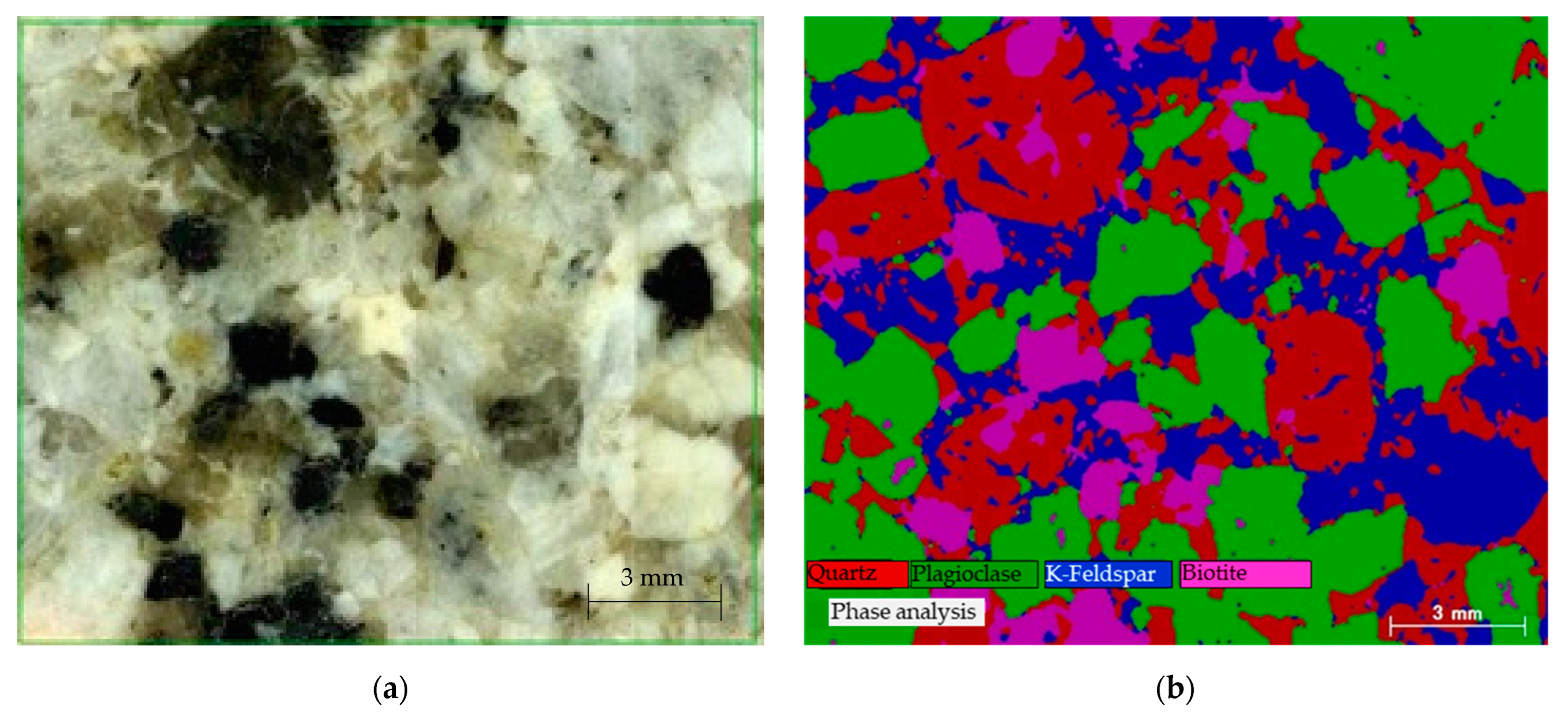
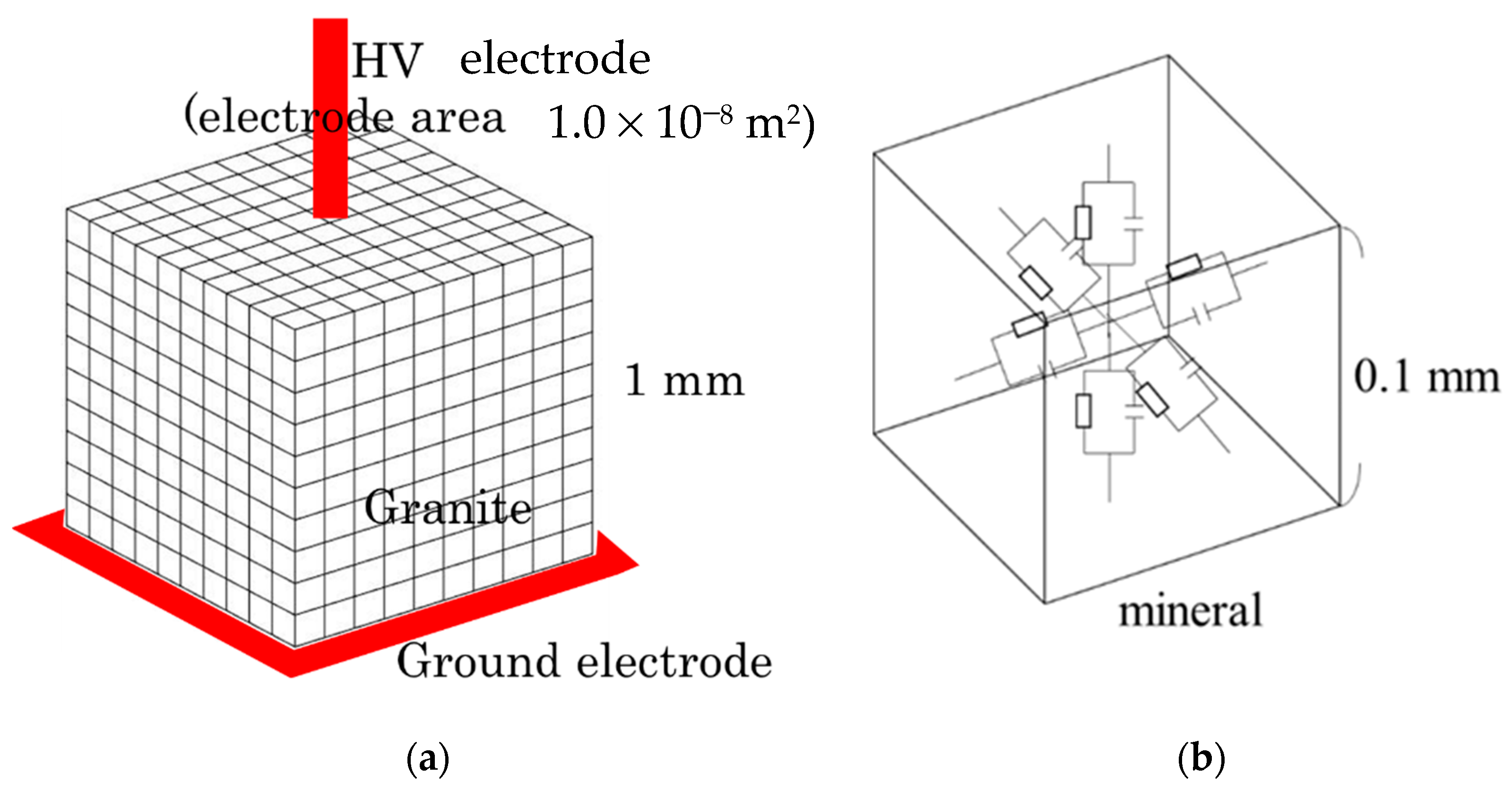
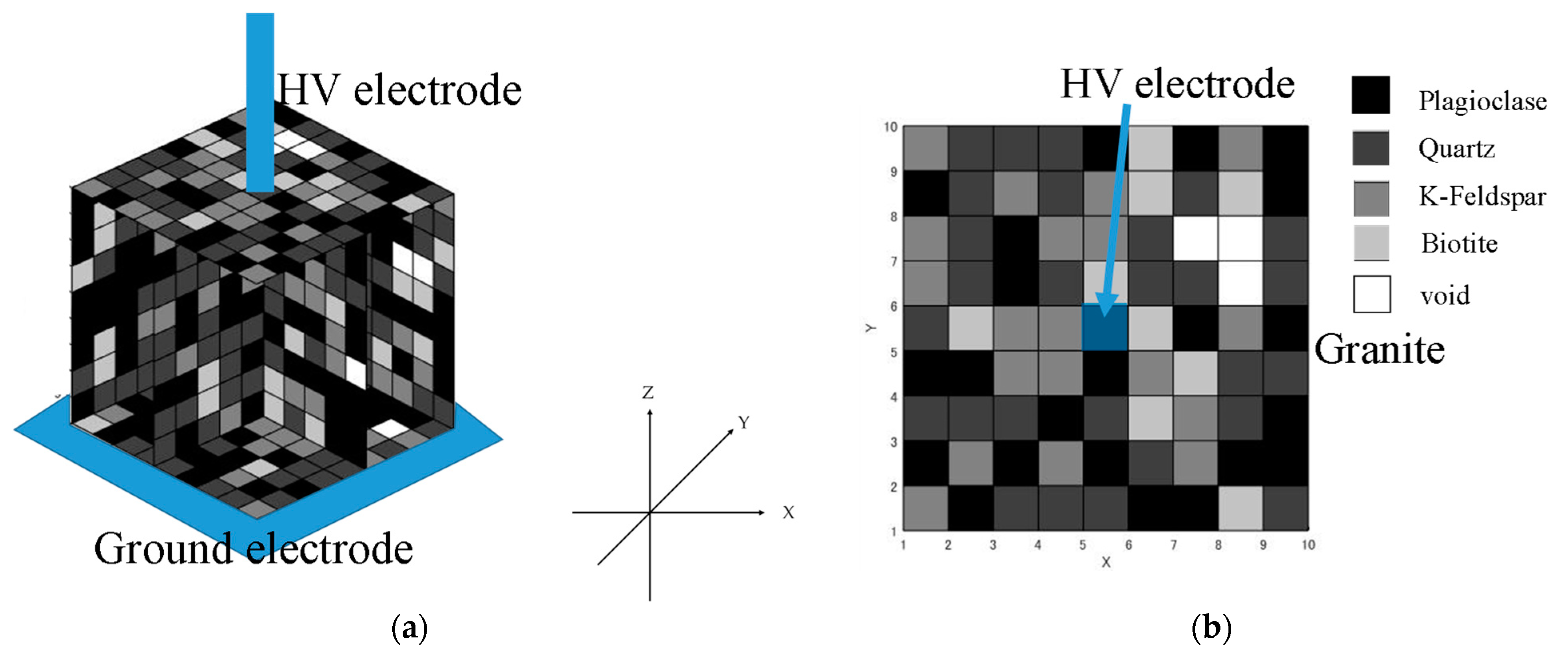
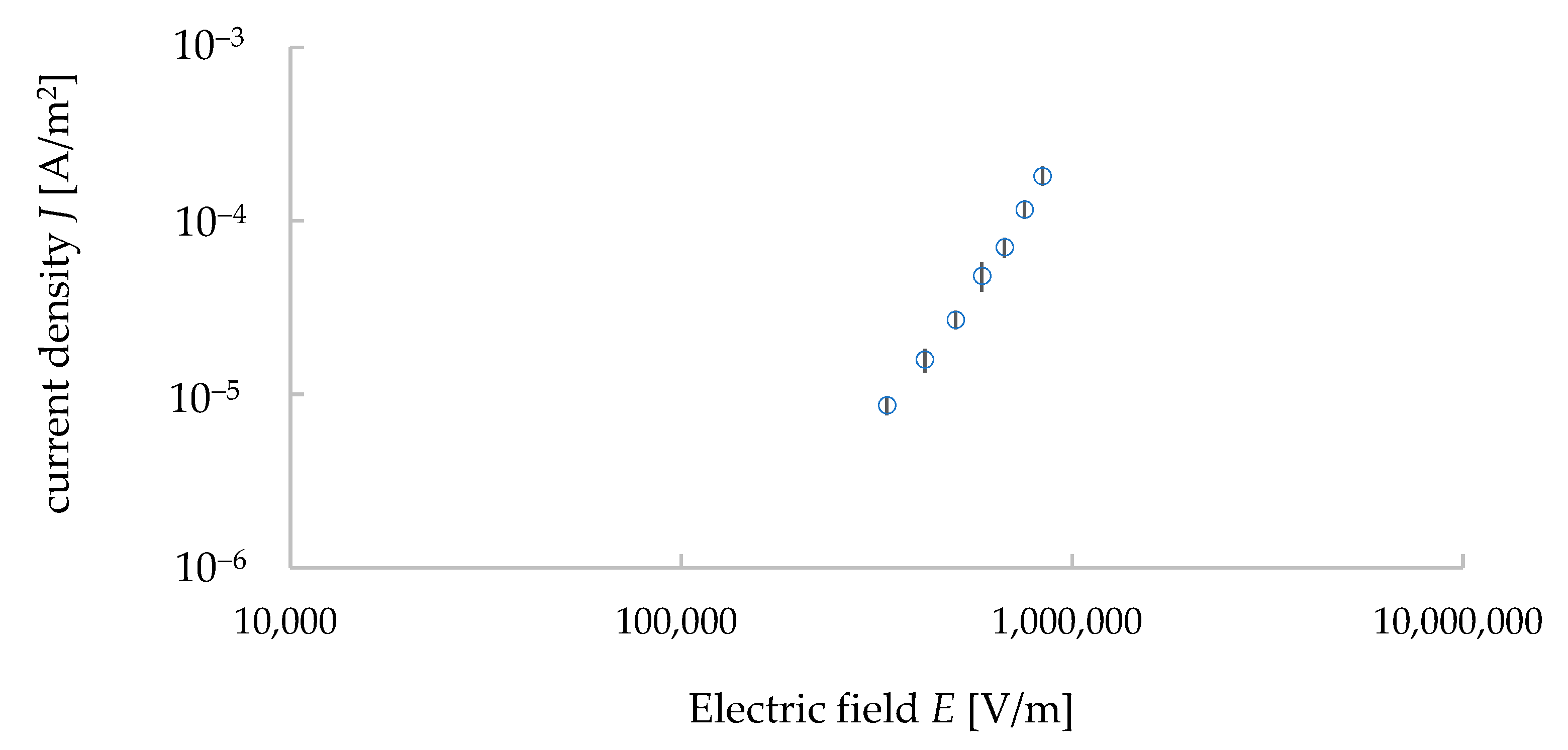
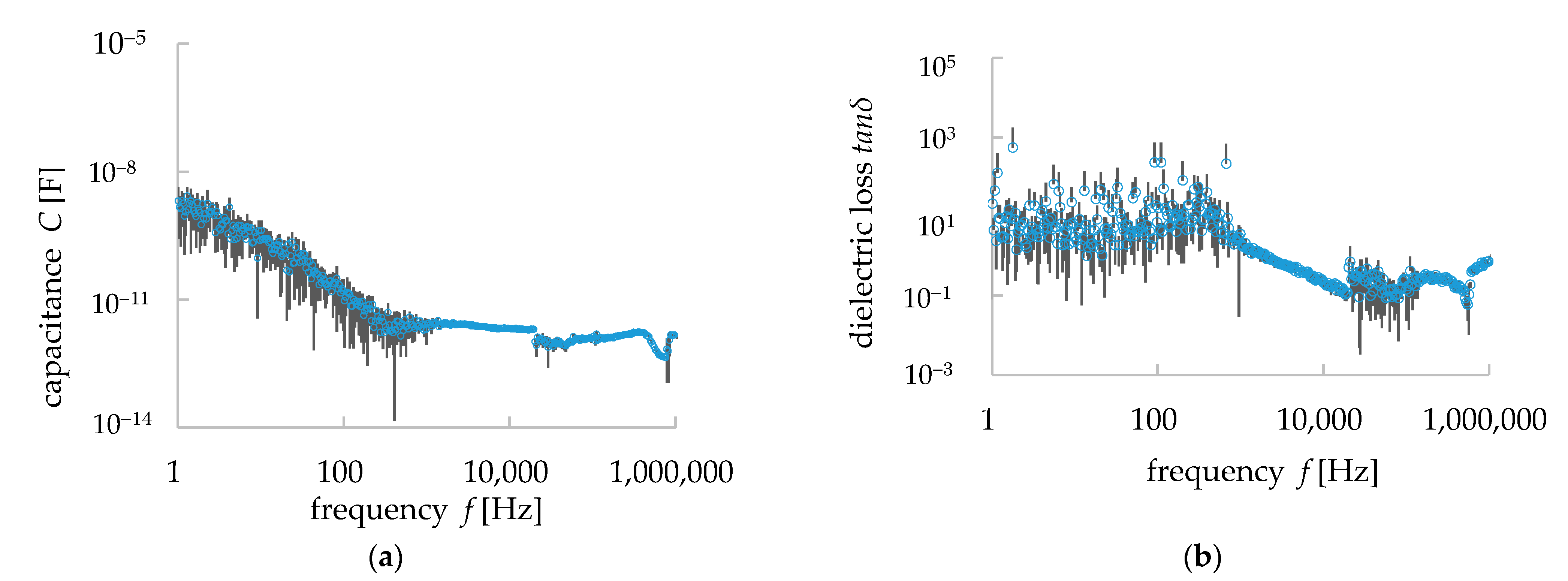
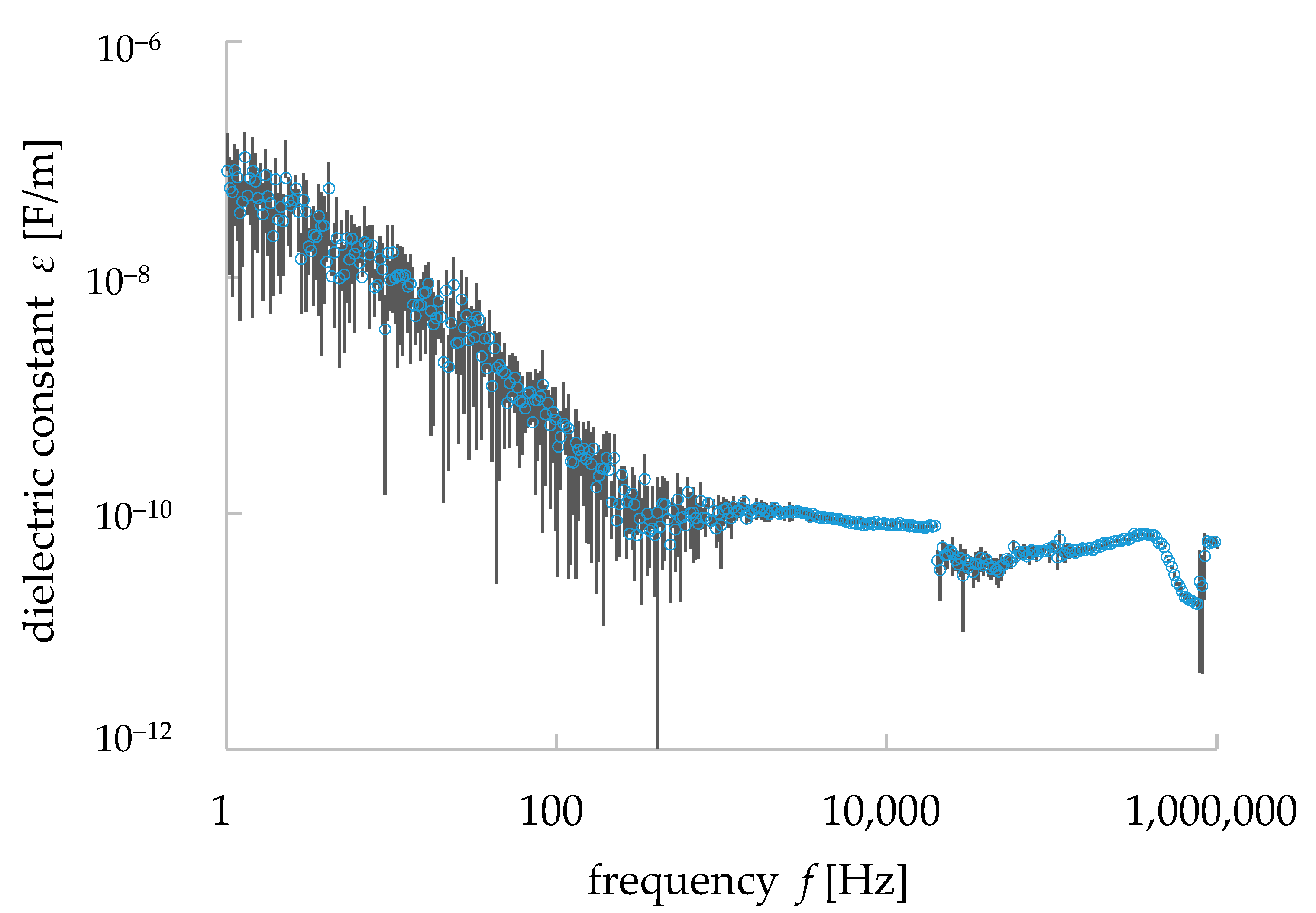
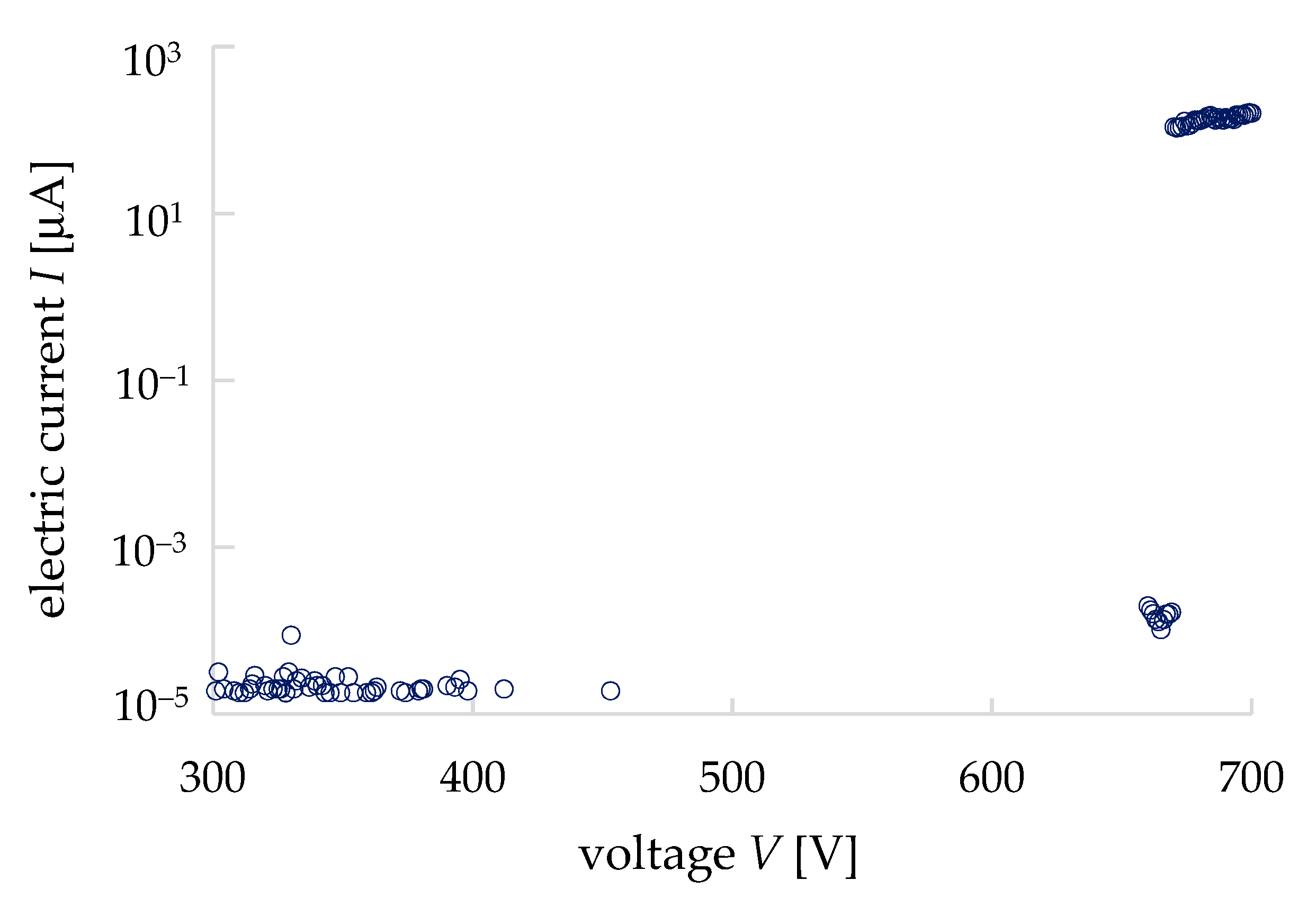

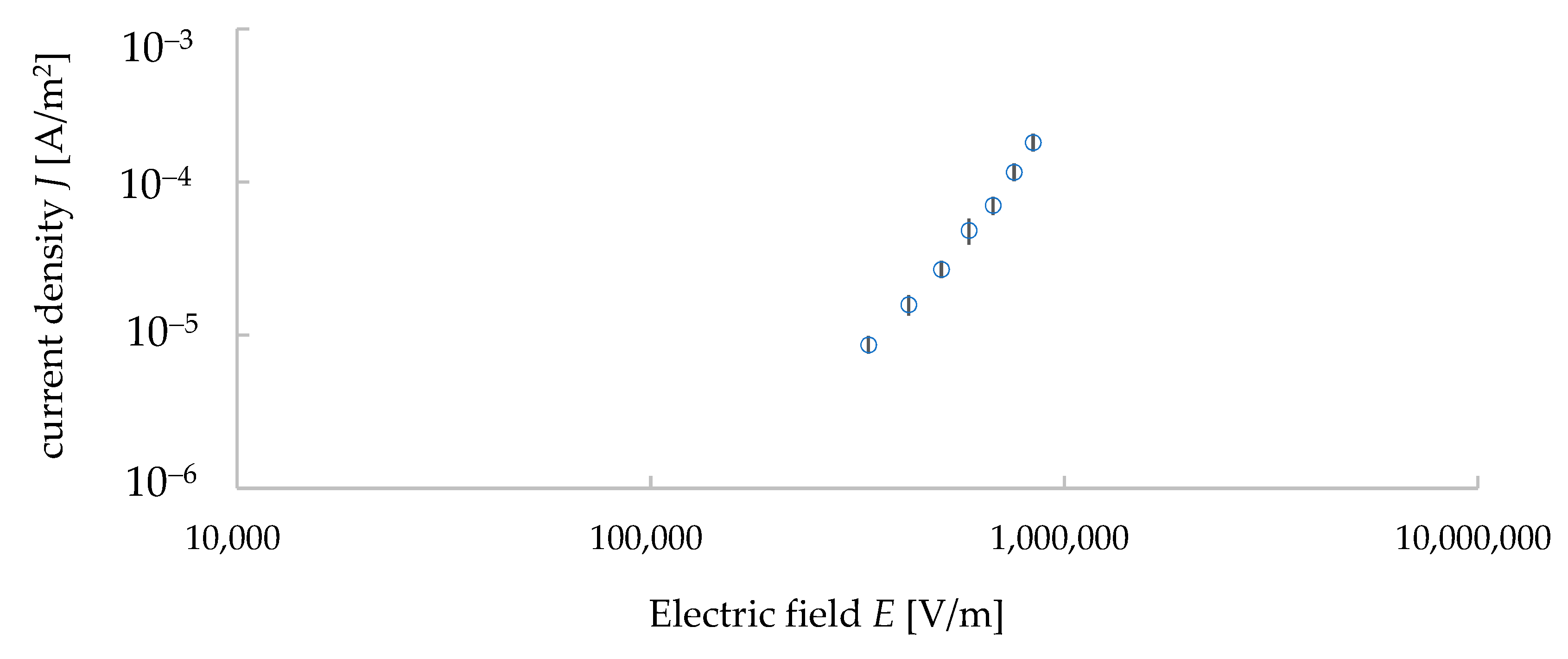
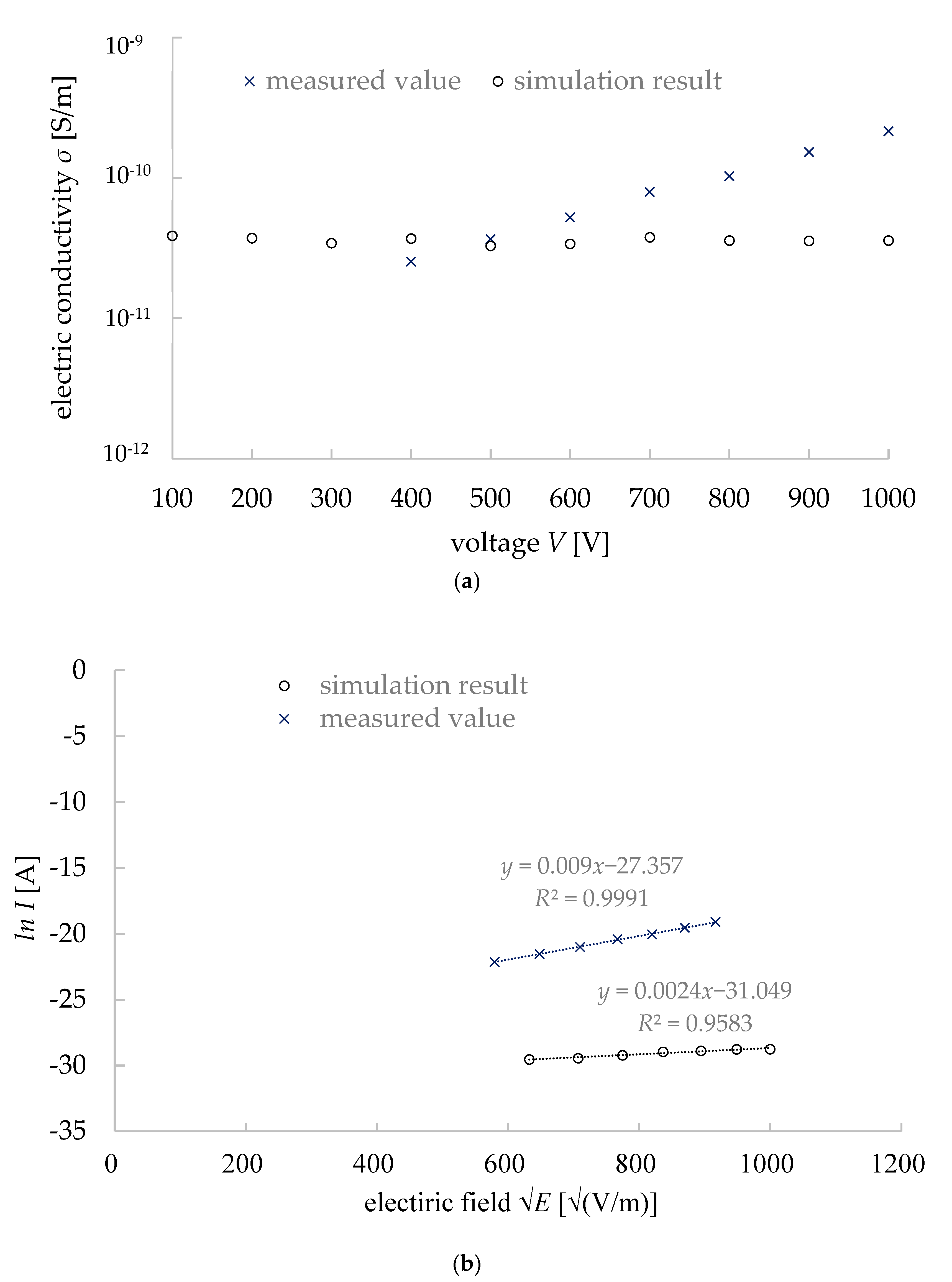
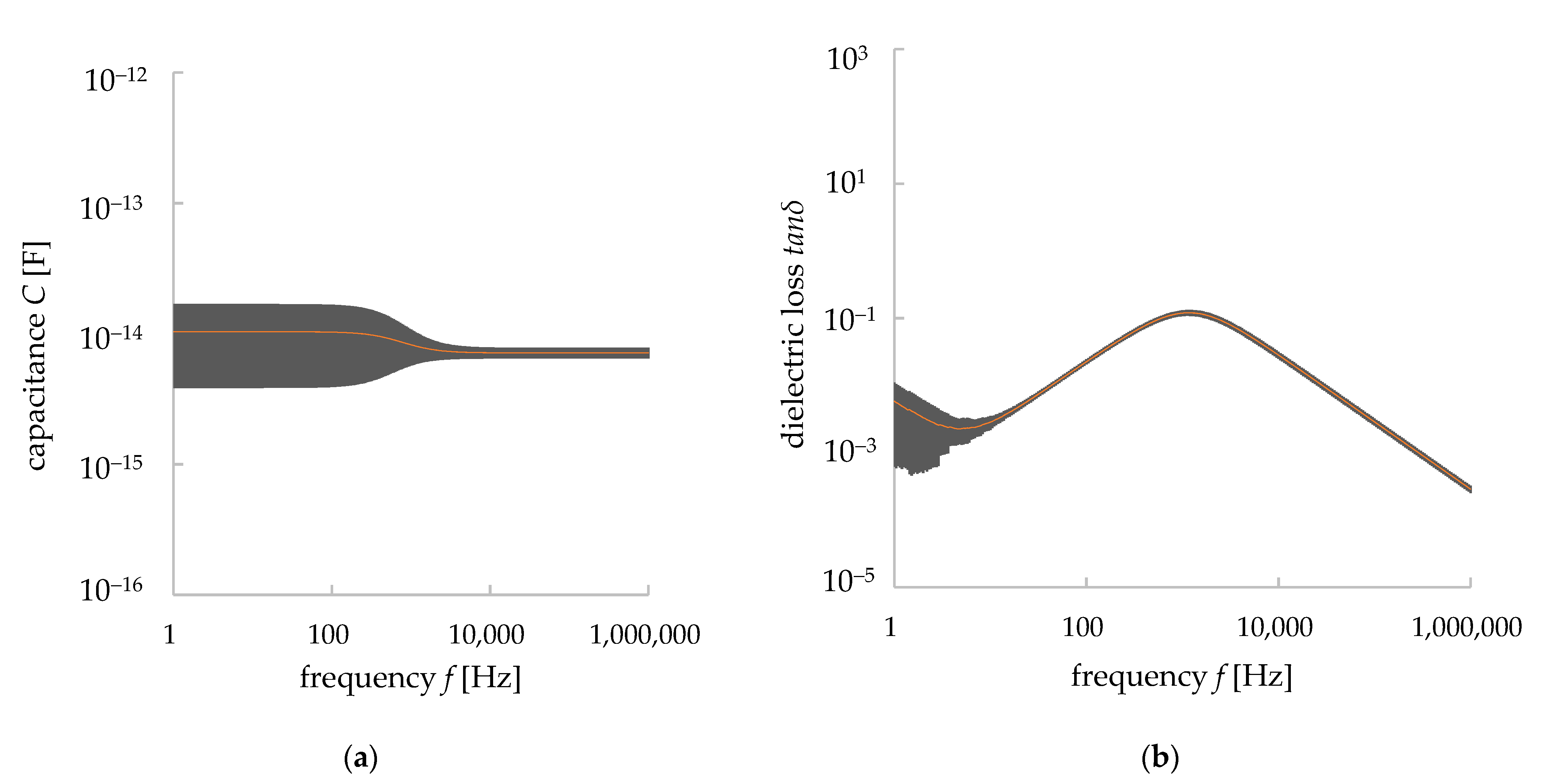

Publisher’s Note: MDPI stays neutral with regard to jurisdictional claims in published maps and institutional affiliations. |
© 2022 by the authors. Licensee MDPI, Basel, Switzerland. This article is an open access article distributed under the terms and conditions of the Creative Commons Attribution (CC BY) license (https://creativecommons.org/licenses/by/4.0/).
Share and Cite
Fukushima, K.; Kabir, M.; Kanda, K.; Obara, N.; Fukuyama, M.; Otsuki, A. Equivalent Circuit Models: An Effective Tool to Simulate Electric/Dielectric Properties of Ores—An Example Using Granite. Materials 2022, 15, 4549. https://doi.org/10.3390/ma15134549
Fukushima K, Kabir M, Kanda K, Obara N, Fukuyama M, Otsuki A. Equivalent Circuit Models: An Effective Tool to Simulate Electric/Dielectric Properties of Ores—An Example Using Granite. Materials. 2022; 15(13):4549. https://doi.org/10.3390/ma15134549
Chicago/Turabian StyleFukushima, Kyosuke, Mahmudul Kabir, Kensuke Kanda, Naoko Obara, Mayuko Fukuyama, and Akira Otsuki. 2022. "Equivalent Circuit Models: An Effective Tool to Simulate Electric/Dielectric Properties of Ores—An Example Using Granite" Materials 15, no. 13: 4549. https://doi.org/10.3390/ma15134549
APA StyleFukushima, K., Kabir, M., Kanda, K., Obara, N., Fukuyama, M., & Otsuki, A. (2022). Equivalent Circuit Models: An Effective Tool to Simulate Electric/Dielectric Properties of Ores—An Example Using Granite. Materials, 15(13), 4549. https://doi.org/10.3390/ma15134549








